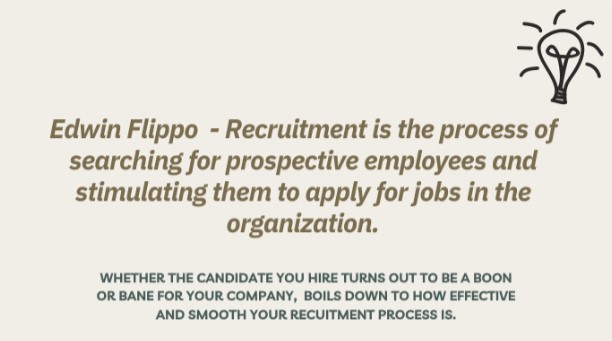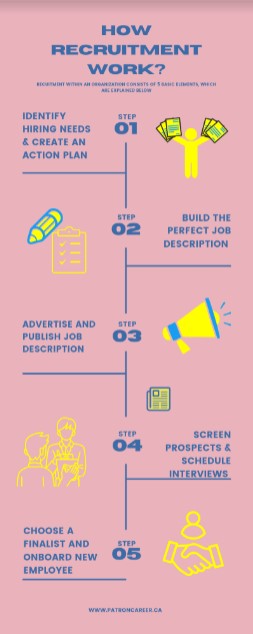
Employee Experience
29 September, 2022
Patron Career Staffing firmly believes in adopting a tailored approach to meet temporary and permanent recruitment needs. We safeguard the interest of our clients by finding such workers who are knowledgeable and reliable.
About UsNeed help? Make a Call
32 Dundas Street East Unit A, L5A1W2

Human capital, as they say, is the most valuable asset for any organization. Without its adequate presence, the very foundation of the organization would completely crumble down. Therefore, for the continual growth of the business, it is highly important to recruit the correct people who are not only ready to fulfill the job requirements but would also be ready to put their noses to the grindstone and lead your company to success.
In this guide, we break down everything from the meaning of recruitment, the need for this essential process, and the steps involved in performing the recruitment from within or outside the organization.
Recruitment in Human Resource Management can be understood as actively finding and hiring the best-qualified candidates (from within or outside of an organization for a job opening, in a timely and cost-effective manner. This process entails analyzing the requirements of a job, revising applications, screening, shortlisting, and finally selecting useful and skilled candidates to fill in such vacant positions.

When dealing with recruitment, remember that you must have proficient, expert employees in your Human Resource, marketing, and operations department or you can hire external recruiters who are well-versed with the norms of recruitment so that there’s no chance of erring and hubbub in employing new talent. To ensure a successful hiring experience, companies must set up a team of professionals to command the recruitment process.
Usually, multinational companies and large organizations have a separate chain of HR managers and teams solely dedicated to handling recruitment in the company. Whereas smaller organizations prefer staffing and recruitment agencies through which they outsource hiring work as it is much more economical and inexpensive for them. Professional recruiting firms put up job adverts to help unite job seekers with their choice of employment roles, such as temporary or permanent employment or contract-based work.
Related: Temporary or permanent employment, what can work for you?
In the event of talent shortage, finding replacements, or inadequate workforce, organizations tend to rely on their recruitment policy or small enterprises seek the help of talent placement agencies. Their work involves hiring candidates to fill in vacant positions either internally e.g. -by transfers and promotions or from external sources e.g. through advertisements. Of course, the main reason behind conducting recruitment is to search and secure highly skilled candidates for the job vacancies to attain organizational goals. But there are a few other reasons behind the importance of the recruitment process:
1. It ensures the continuity of the business when the right candidates are placed in the right positions.
2. It helps accumulate a talented and well-qualified workforce adamant to achieve organizational goals.
3. Employee retention is jeopardy, common to all businesses whether big or small. Efficient recruitment if done properly can minimize the risk of people leaving your company.
4. A business becomes capable of analyzing the present and future staffing requirements through the recruitment process.
5. It ensures the smooth functioning of the business concern. The daily operations and other business activities are run seamlessly with the presence of an adept and adequate workforce.
6. It promotes the business value and helps one gain popularity. Recruitment is a process that invites a wide range of talent pools to apply for open positions in a company. The more you advertise, the more people know about your company.
7. The job applicants are filtered based on under and overqualified, which saves the time of the individuals and business owners and in turn, leads to effective hiring.

All organizations, irrespective of big or small, should devise a recruitment strategy depending on their size, structure, nature of work, overall economic condition, the growth rate of the organization, and other considerations.
The following are the main steps involved in recruitment:
1. Recognise company needs- this is the first step whereby the designated recruitment team of professionals enlist basic requirements behind initiating the recruitment process. It can vary according to the vacancies available in the organization, skills, and experience required for a particular job, or even point specific requirements such as the ability to stand on feet for a longer duration. It helps to identify the exact hiring needs of the company.
2. Create a stellar recruitment plan- this step enables a company to streamline the hiring process. The recruiters outline and draft the big picture of the recruitment process- from finding candidates, to screening and selecting the best of the slot. Through this plan, they strategize how they’re going to come about recruiting potential candidates for the organization. Remember there can be different recruitment plans for different positions.
3. Perform job analysis- it involves comprehensive analyzing and determining the skills, abilities, duties, and responsibilities that a job will demand. A job description is done to specify the scope of the job and job title, responsibilities and competencies required, experience, qualifications, etc. It also covers other information related to the hours of work, compensation, working environment, and location of the work in question. A clear and cogent job description helps candidates to know what is expected of them while filling out the forms.
4. Advertise the positions- now that you have drafted job description, the next step is to publish the job advert to share it more widely. It can be done through social media, online job sites, billboards, or even can be posted directly on your company website. Make sure to amp up your job posting by creating attractive ads and inviting people to apply for the job.
5. Shortlisting- it is also known as screening. This means compiling a list of top talent amongst numerous applicants by dividing candidates into qualified, unqualified, and irrelevant candidates based on their cover letters ad resumes. The main purpose is to source candidates to match the job requirements.
6. Interview candidates- this is an elongated step in the screening process. The hiring managers contact selected candidates to appear for telephonic, in-person, or virtual interviews, depending upon their resources and the number of applicants. Through the interview, they learn more about the candidates and it makes the process much easier for them.
7. Candidates assessment- this is an evaluative step to detect the best fit for the role. It may include background checks, reference checks, or conducting personality-type tests to make the best decision.
8. Contract signing and enlisting- finally, in this last stage of recruitment, if the selected candidates accept the job offer, then the hiring team can close the process of hiring, sign off and move on to the induction and orientation process.
Related: Related: Orientation and induction of employees.
As an organization, you can perform evaluation and control to check the validity of the recruitment process and assess its effectiveness. It is important to gain insights into the costs incurred in the recruitment process such as advertising costs or staffing agency fees, recruitment overhead, interview costs, and other administrative expenses.
